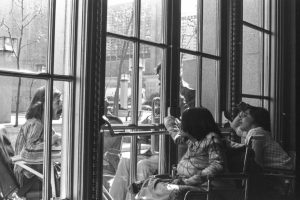
Image of Mike Williams, Nancy D’Angelo, and Judy Heumann protesting in and outside of federal offices in San Francisco in April of 1977. Photo by HolLynn D’Lil at the New York Times.
UW’s 50th Anniversary of Section 504: Learn, Celebrate, & Innovate
The following post was originally published by the Office of the ADA Coordinator at the University of Washington.
September 25, 2023 – Welcome to the University of Washington’s commemoration of the 50th Anniversary of Section 504 of the Rehabilitation Act. In 1973, this landmark legislation laid the foundation for equal access and opportunities for individuals with disabilities, sparking a transformative journey towards inclusivity that continues to shape our institution.
As we honor this historic milestone, we invite you to explore our website to discover a rich tapestry of stories, events, and engagement opportunities that reflect our unwavering commitment to diversity, accessibility, and social justice. Join us in celebrating the progress made over the past five decades and the exciting strides ahead as we build a more inclusive campus together.
From enlightening historical retrospectives to thought-provoking conversations with trailblazers in disability rights, our 50th Anniversary platform is a hub of knowledge and community engagement. Together, we not only reflect upon the past but also illuminate the path forward toward a more equitable and accessible future.
About Section 504
Section 504 of the Rehabilitation Act of 1973 was the first civil rights protection in the United States to prohibit discrimination against individuals with disabilities in programs and activities that receive Federal funding. The text of Section 504 states that:
“No otherwise qualified individual with a disability in the United States… shall, solely by reason of his or her disability, be excluded from participation in, be denied the benefits of, or be subjected to discrimination under any program or activity receiving Federal financial assistance…”
Section 504 regulations applies to all recipients of this funding, including colleges, universities, post-secondary vocational education and adult education programs. For more information, consult Section 504 of the Rehabilitation Act.
Implementation of 504
Although Section 504 was the first civil rights protection for disabled Americans, the provisions of 504 would not be enforced until the tireless advocacy of disabled activists and cross-movement organizations. From 1973 to 1977, no regulations were published or mandated by the national government. In turn, these groups began forming and organizing to demand the implementation of 504 and rights of disabled Americans.
In 1977, disabled activists staged sit-ins at federal buildings across the country to demand the national enforcement of 504. Most notably, the sit-in in San Francisco lasted 26-days, marking the longest occupation of a federal building to date. As a result of these activists’ efforts in San Francisco and across the country, the government signed the regulations into law on April 28, 1977.
The implementation of Section 504 radically transformed society and education for disabled Americans. 504 furthermore laid the foundation for subsequent advancements in disability rights legislation, such as the Americans with Disabilities Act (ADA) of 1990.
Resources for Continued Learning
- Before the ADA, There Was Section 504 — A New York Times article uplifting the history of disability rights activism that lead to the passage of the Americans with Disabilities Act. Article includes photos from the 504 Sit-Ins from 1977.
- Judy Heumann Fights for People with Disabilities — An 8 minute Comedy Central episode commemorating disability rights activist Judy Heumann in her fight for the implementation of Section 504 and passage of the Americans with Disabilities Act.
- Short History of the 504 Sit-in — A brief article highlighting the historical context of the development of Section 504, the struggle to enshrine regulations on a national scale, and the importance of disability rights activism in enacting the provisions of 504.
- Patient No More — A virtual tour of the Patient No More Exhibit by the Paul K. Longmore Institute on Disability at San Francisco State University, highlighting the history of why disability activists occupied a government building to demand their rights and enforce Section 504.
- The Power of 504 — An award-winning 18-minute documentary capturing the emotions and stories of the historic civil right demonstration of people with disabilities in 1977, includes news footage and interviews with participants and leaders.
- Voices of 504 — A few testimonies of leaders and participants of the Section 504 Sit-In, highlighting the importance of the demonstration and regulations of 504.
- 504 at 50 Podcast by the Southeast ADA Center — A special interview series created in recognition of the 50th anniversary of the signing of the Rehabilitation Act of 1973. In this series, the Center speaks with people who are leaders in the Disability Rights Movement, who advance the cause of equal rights through their tireless work.
Read the original article, and view additional resources, and promotional materials.



